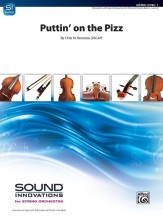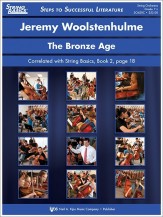LEVEL UP Your Orchestra! Wednesday, March 30, 2022
8 Fun Compositions to turn your beginning orchestra up a notch
#makethemostmusic #dedicationtoeducation #programwiththepros #sheetmusicspecialists #bewherethemusicis #stantonssheetmusic #sheetmusic #musiceducation #musicteacher #musiced #musiceducator #musiceducationmatters #conducting #musicdirector #music #columbusohio #columbusmusic #columbusmusicians #columbusmakesmusic
recommended by Megan W., Orchestra Specialist
Little Critters by Brian Balmages, Grade 1
The vivid imagery of “little critters” scurrying about at night inspires the melodic lines and creative harmonies used throughout this programmatic work. Beginning soft and mischievous, the music builds as new critters join the fun in a playful dialogue. The harmonic language moves between moments of pleasant consonance and slight dissonance (because as we all know, some people love little critters and some people are terrified of them!). A highly imaginative, playable work!
Robot Factory by Chris M. Bernotas, Grade 1
Special effects, pizzicato, and a variety of dynamics will make “Robot Factory” by Chris M. Bernotas exciting for your beginning orchestra students. The key of E minor provides a dark sound, and all sections get to play the energetic melody! This piece will be a great feature or perfect closer to any contest or concert.
Five Before Beethoven by Brian Balmages, Grade 1.5-2
A great compliment to the composer’s popular work “A Beethoven Lullaby,” this original piece pays homage to Beethoven’s fifth symphony, immersing students in the style of the first movement without feeling like they are playing a watered-down arrangement. Conductors will surely notice the many nods (both subtle and not so subtle) to Beethoven’s masterpiece while also exploring original themes.
Puttin’ on the Pizz by Chris M. Bernotas, Grade 1
“Puttin’ on the Pizz” by Chris Bernotas is sure to become a favorite selection of students and directors. The descending bass line sets the stage for this fun piece. All notes stay in first position and the string orchestra plays pizzicato throughout. Students also have the chance to act as the percussion section. With the optional use of ‘swinging’ eighth notes, “Puttin’ on the Pizz” could be a fun way to introduce a jazzy style to the string orchestra. Everyone in the audience (and in the orchestra) will be tapping their toes to this piece. Violin 2 and Viola are doubled, as are Cello and String Bass, which will work perfectly for younger string orchestras.
Perpetuum by Paul Barker, Grade 2.5
“Perpetuum” is a lively and contemporary addition to any concert performance with its memorable melodic lines and relentless driving rhythms. The piece begins with a powerful introduction to the main theme which is ingeniously augmented as the piece powers forward. The middle section provides a warm, lyrical contrast performed by the lower strings. The main theme returns with a wall of sound heading to a dramatic close. This beautifully expressive and contemporary work is a nice change of pace for orchestra students. Using the optional percussion parts are highly recommended for optimal effect.
Danza de mi Corazón (Dance of My Heart) by Steven L. Rosenhaus, Grade 2.5
Composer Steven Rosenhaus always strives to have his music connect emotionally with players and audiences alike. This energetic work does that and makes you want to dance too! It’s truly a “dance of the heart.”
The Bronze Age by Jeremy Woolstenhulme, Grade 1.5
“The Bronze Age” is an energetic work featuring accents and meter changes from 3/4 to 4/4. It’s in E minor and all music is in 1st position. A Learning Bank is included jam packed with information about this prolific time during prehistoric times when the discovery of bronze contributed to the making of strong weapons, tools, utensils, and more.
The Monster Named Stretch by Anthony Granata, Grade 2.5
Written in the eerie key of F-sharp natural minor that attracts young students, this sound defines our scary monster called “Stretch.” Each section gets important melodic and countermelodic material. With two separate sections (slow and fast), a legato middle section, a jaunty pizzicato section, and a forceful coda, every section will be challenging. The work features simple rhythm patterns to make it more accessible and allow the student to focus on the three sharps.
Shop Stanton’s for all your sheet music needs!
About the Author:
Megan W., originally from Pittsburgh PA, is happy to call Columbus and Stanton’s Sheet Music “Home.” As a musician, Megan has played in marching and concert bands, youth orchestras, full orchestras, small ensembles, and a few choirs. Her interests include fiddling, reading, writing, martial arts and yoga.


